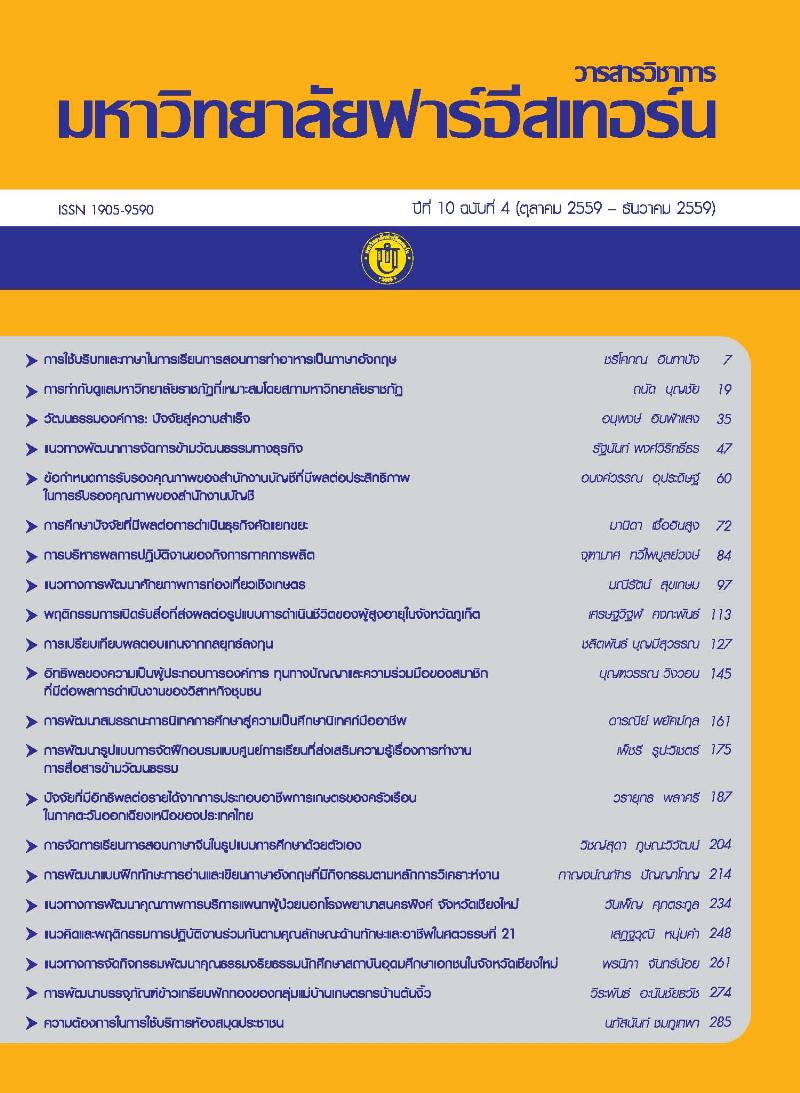การบริหารผลการปฏิบัติงานของกิจการภาคการผลิตในจังหวัดชลบุรี
Main Article Content
Abstract
การศึกษานี้มีวัตถุประสงค์เพื่อ 1) ศึกษาถึงการบริหารผลการปฏิบัติงานของกิจการภาคการผลิตในจังหวัดชลบุรี 2) เปรียบเทียบการบริหารผลการปฏิบัติงานระหว่างกิจการที่ชาวไทยเป็นผู้ลงทุนกับกิจการที่มีผู้ร่วมทุนกับต่างชาติ และ 3) เปรียบเทียบการบริหารผลการปฏิบัติงานระหว่างระหว่างกิจการที่มีขนาดเล็ก ขนาดกลาง และขนาดใหญ่ การวิจัยใช้การวิจัยเชิงสำรวจ กลุ่มตัวอย่างในการวิจัยได้แก่กิจการภาคการผลิตที่อยู่ในจังหวัดชลบุรีจำนวน 380 แห่ง โดยใช้สุ่มตัวอย่างแบบหลายขั้นตอน ใช้ค่าร้อยละเพื่ออธิบายรูปแบบการบริหารผลการปฏิบัติงานของกิจการ และใช้สถิติไคสแควร์ในทดสอบสมมติฐาน
ผลการศึกษาพบว่า กิจการร้อยละ 93.7 มีการกำหนดมาตรฐานในการปฏิบัติงาน ร้อยละ 64.2
มีการประเมินผลการปฏิบัติงานอย่างเป็นทางการ โดยวิธีการประเมินผลการปฏิบัติงานที่ใช้มากที่สุด คือ ใช้วิธีการให้คะแนนตามมาตรส่วน การประเมินถูกใช้เป็นเครื่องมือในการพิจารณาการขึ้นเงินเดือนประจำปีมากที่สุด โดยกิจการส่วนมากมีการแจ้งผลการประเมินและมีการให้คำแนะนำหลังการประเมินในตำแหน่งงานที่แจ้งผลการประเมิน เพื่อให้ผู้ถูกประเมินนำไปปรับปรุงผลการปฏิบัติงานในอนาคตได้ ทั้งนี้ กิจการ
ที่มีผู้ร่วมลงทุนต่างกันและกิจการที่มีขนาดแตกต่างกัน มีการบริหารผลการปฏิบัติงานที่แตกต่างกันอย่าง
มีนัยสำคัญที่ระดับ 0.05
การศึกษามีข้อเสนอแนะต่อกิจการในเรื่องการชี้แจงผลการประเมินผลปฏิบัติงานให้ผู้ถูกประเมินทราบ การสร้างระบบการบริหารผลการปฏิบัติงานที่เหมาะสมกับบริบทของกิจการ ได้แก่ ขนาดของกิจการ วัฒนธรรมการทำงานของกิจการ
The objectives of this research were: 1) to study human resource management practices of manufacturing firms in Chonburi province in the area of performance management, 2) to compare performance management between Thai firm and joint venture firms with foreign investor and 3) to compare performance management among small, medium, and large firms. The survey research was used. The sample, 380 manufacturing firms in Chonburi province, were collected by multistage sampling technique. The percentage were used to describe performance management practices of firms and Chi-square were used for hypothesis testing.
The results of this research revealed that 93.7 of the firms had performance standard, 64.2 percent of the firms used formal performance appraisal process. Graphic rating scale method was most used in appraising. The results of appraising were mostly used in determining salary raise. Most of the firms had performance feedback and suggestion process after appraising for the reason of performance improvement in the future. The firms with different investors and different size had different performance management practices with statistical difference at level of 0.05.
The study has the recommendation to the firms in clarifying the results of performance in feedback process, developing appropriate performance management system that suitable for firm context, including firm size and work culture.
Article Details
1. Any views and comments in the Journal of Social Innovation and Lifelong Learning are the authors’ views. The editorial staff have not to agree with those views and it is not considered as the editorial’s responsibility.
2. The responsibility of content and draft check of each article belongs to each author. In case, there is any lawsuit about copyright infringement. It is considered as the authors’ sole responsibility.
3. The article copyright belonging to the authors and The Far Eastern University are copyrighted legally. Republication must be received direct permission from the authors and The Far Eastern University in written form.
References
สำนักงานส่งเสริมวิสาหกิจขนาดกลางและขนาดย่อม. (2557). รายงานสถานการณ์ SMEs ปี 2557. สืบค้นเมื่อ 1 พฤษภาคม 2558, จาก http://www.sme.go.th/th/index.php/data-alert/alert/report-smes-year/
Ball, G. A., Trevino, L. K., & Sims, H. P., Jr. (1994). Just and unjust punishment: Influences on subordinate performance and citizenship. Academy of Management Journal, 37: 299-322.
Barnard, C. I. (1938). The functions of the executive. Cambridge, MA: Harvard University Press
Bogardus, M. A. (2007). PHR/SPHR: Professional in Human Resources Certification. Indianapolis: Wiley Publishing.
Chew, I.K.H. & Goh, M. (1997). Some future directions of HR practices in Singapore. Career Development International. 2(5), 238-244.
Cobb, A. T., & Frey, F. M. (1996). The effects of leader fairness and pay outcomes on superior/subordinate relations. Journal of Applied Social Psychology, 26: 1401-1426.
Dessler, G. & Huat, T.C. (2006). Human Resource Management: An Asian Perspective. 1st ed. Singapore: Prentice Hall, Inc.
Kirkbride, P.S. & Tang, S.F.Y. (1989). Personnel management in Hong Kong: A review of current issues. Asia Pacific Human Resource Management. 27(2), 43-57.
Nyaw, M.K. (1995). “Human resource management in the people’s Republic of China” in Moore, L. F. and Jennings, P.D. (eds) Human Resource Management on the Pacific Rim. Berlin and New York: Water de Gruyter, 187-216.
Prasad, L.M. (2006). Human Resource Management. Sultan Chand & Sons: Educational Publishers.
Poon, J.M.L. (1993). Korean subsidiary companies in Malaysia: management practices and investment motives. Malaysian Management Review. 28(1), 9-16.
Venclová, K., Šalková, A., & Koláková, G. (2013). Identification of employee performance appraisal methods in agricultural organizations. Journal of Competitiveness. 5(2), 20-36.
Yamane, T. (1973). Statistics: An Introductory Analysis. 2nd ed., New York: Haper and Row Press.

